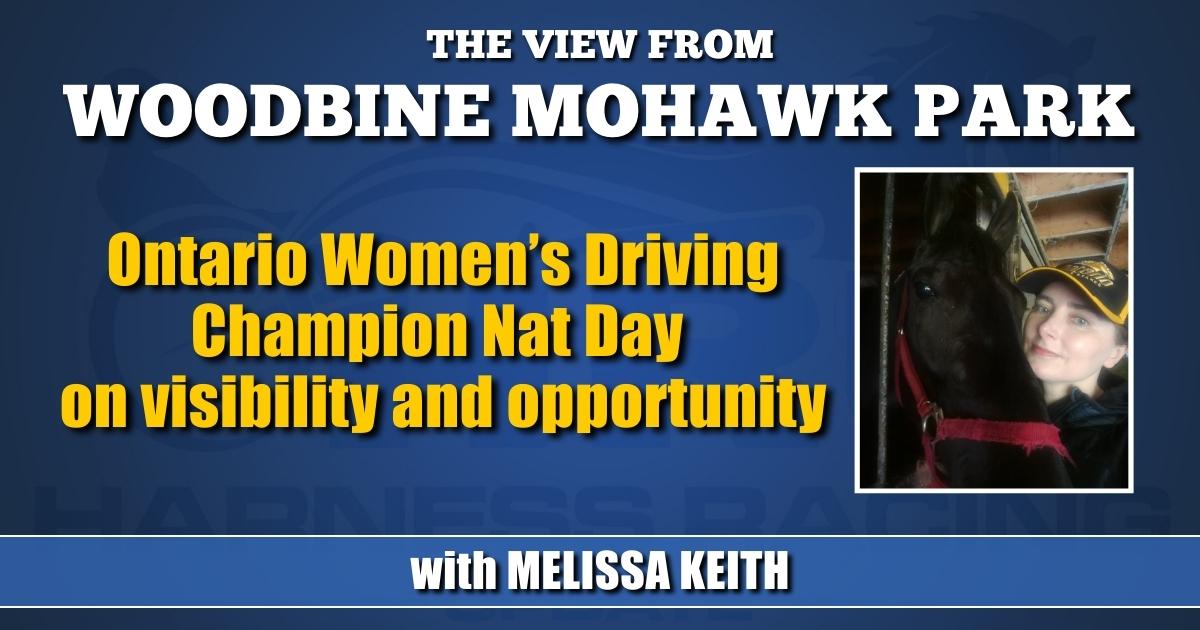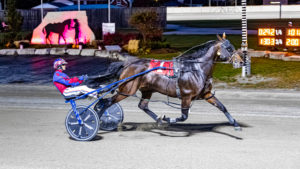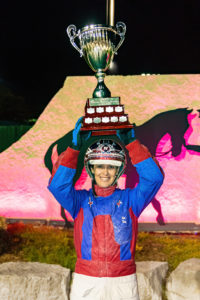

Ontario Women’s Driving Champion Nat Day on visibility and opportunity
The two-time champ won six races in a row at Western Fair to take the title.
by Melissa Keith
On Friday (Oct. 14) at The Raceway at Western Fair, Natasha “Nat” Day captured her second consecutive OLG Ontario Women’s Driving Championship title. It’s how she repeated that was particularly noteworthy: Day drove six winners in a row, none in races with short fields, and only one from the rail. Saturday evening, the newly-minted champion was going to Flamboro Downs to qualify Melissa Lamoureux’s trotter Magnolia Lane, not driving at Woodbine Mohawk Park. No one in the North American harness racing industry will consider the fact surprising, despite her sweep in the 2022 women’s driving series and going six-for-six in the London, ON finals.
This surpassed a previous record set Aug. 11, 1985, when Danielle Duquet won 5 of 10 races on a single card.
Day questioned why so many in North America hold female drivers in low regard. She said that her points advantage going into the finals for the 2022 Women’s Driving Championship series didn’t guarantee victory, because of her talented Ontario rivals.
“You know what? I didn’t feel comfortable at all that I had a huge lead and nobody was going to touch me,” she said. “Marielle [Enberg] is very competitive. Julie [Walker] is very competitive. I mean, all the girls are competitive…I did the best with what I had, and just got lucky that I got horses that had gate speed.”
Going undefeated into race 5, Day joked that her reputation was on the line with trotter Jayport Roadrunner, owned by fellow driver Tyler Borth: “I knew I had to win this one. The pressure was really on. I thought I’d be scrutinized by basically every driver at London.”
Her historic six-race win streak was capped off in the final leg, in which Day said she felt least confident. She was familiar with two-time 2022 winner Azucar Pipedream from various Ontario “B” tracks, and added a third victory to the mare’s seasonal stats Friday evening.
“She was good last night. I just had to send her and that was it,” said Day. “She paid attention last night.”
Day’s toughest competition in the Women’s Driving Championship was Marie-Claude Auger, who remains on racing hiatus for health reasons.
“That’s a huge shame and a huge loss,” said Day. “All the girls feel so bad for her, leaving indefinitely from driving, because that’s her livelihood.”
Importantly, Auger was the only series driver besides Day who was regularly racing against male drivers, primarily at Rideau Carleton Raceway. When Woodbine Mohawk Park played host to two special races for female drivers this year, Day won with Mach My Kiss on March 7 and Auger won with Dark Moves on Aug. 15.
There are no female drivers regularly based at Canada’s top track today, with the most recent being Riina Rekila. She last drove at Mohawk in 2016 before returning to Finland, where she continues to enjoy considerable success with her Wania Racing stable.
“We need more women out there. I don’t understand why we haven’t moved forward like other countries,” Day told HRU. The Queensland, Australia native said that the rarity of female pari-mutuel drivers in North America seems rooted in stubborn beliefs about who can outmuscle a horse: “I can’t explain why it’s like this, why so many owners and trainers believe, ‘I have the horses and you’re not physically good enough.’”
Imagine driving a horse to victory, only to lose the drive in that horse’s next race for the same connections. “It really annoys me,” said Day, noting that when the best women are passed over for catch drives, it reinforces the problem and keeps others from trying.
Familiar questions run through her mind whenever it happens: “Why aren’t you ‘good enough’? Why aren’t more of these girls ‘good enough?’”
Objectively, Day knows she’s more than good enough.
“It says on my license I’m a driver. I’m an ‘A’ grade driver. It doesn’t say ‘woman driver’, so why do you call me a woman driver?”
Women’s races at Woodbine Mohawk Park this year were beneficial to female drivers’ visibility and credibility, in her view.
“It was good to go there to Mohawk and experience driving on the mile track,” said Day, who primarily drives at half-mile ovals. “It’s great to take in that atmosphere and it’s a totally different driving experience as well. If you want to get the experience, you’ve got to go down there and do it. All of the girls really enjoyed it and they put on such a great show for us.”
Yet aside from special events, there is a stubborn reluctance among trainers and owners (“a lot of older gentlemen”) to list female catch drivers. Day said even back-to-back Ontario Women’s Driving Championship titles hasn’t translated into more drives, particularly at Mohawk.
“I’d love to say yes, but I can’t even guarantee that it will help me drive more,” she said. “I hope the series will make people stand up and take notice, not only for myself but for the other girls as well.”
She identified three main barriers to greater female participation as catch drivers in North America. First, many of the best-known women drivers have a husband or family with a powerful stable: “It’s not uncommon.” Women drivers are also usually trainers: “Take nothing away from Riina [Rekila] – she’s a really good driver, and she’s winning races over there in Sweden too, so it’s definitely not anything against her. But if you have to train and drive your own horses to get to that level [i.e. driving at Woodbine Mohawk Park], it’s an issue.”
Day doesn’t consider herself a trainer who occasionally drives: “I’m the other way around. I have three horses,” she said.
Raised in Queensland, Australia, Ontario’s busiest female driver grew up in a racing family, but took initiative on her own to become licensed as soon as possible.
“Dad was a trainer/driver and I’ve been driving since I was 16, and I’ve driven ever since. I’m 44 now.”
The topic leads to Day’s second reason for the lack of female catch drivers.
“One of our biggest problems is we start off driving too late,” she told HRU, noting that Australia’s “pony trots” raise skill and confidence in young girls and boys learning to drive. “They’re not allowed to go out there and gallop. The ponies have to trot. I think we’ve missed that chance over here. They can get the experience before they even take a horse on the track. I think it’s so much better.”
She challenged other participants in the Women’s Driving Championships to follow the path of herself and Auger by making more pari-mutuel starts.
“I actually said to Julie Walker, ‘Julie, you need to start driving more,’” said Day, who tallied 118 total points in the series, ahead of runners-up Marielle Enberg and Walker, who both finished with 80 points.
A third barrier for North American women drivers is the promotion of stereotypically-pretty girls ahead of those with the most ability, according to Day.
“It really needs to change and we really need to come to terms with the modern age,” she said. “It’s very archaic here sometimes.”
Meanwhile in August, the 2022 Australian Drivers’ Championship featured a record five women in the field of 12 top drivers: Kate Gath, Dani Hill, Emily Suvaljko, Grace Panella, and Narissa McMullen. It was not billed as a novelty “Battle of the Sexes.”
Saturday night at Woodbine Mohawk Park was the Ontario Sires Stakes Gold Super Finals.
“I’ve got the Women’s Driving title and I don’t even have a drive there,” said Day, whose 2022 record at the track (two wins, one place and two show finishes from 16 starts) puts her 37th of 100 drivers with at least a single seasonal start there. Several male catch drivers with a UDRS near her current .201 drove throughout the card.
“With a huge driving colony, a lot of guys are like, ‘Well, why would you put her on when we have the leading drivers at Flamboro?’ And you kind of get shuffled down the ranks,” she said with disappointment.
Day continues chasing her first 100-win season, picking up drives at tracks around Ontario. She hopes that more owners and trainers will open their minds about listing female catch drivers, particularly on better horses at Canada’s top track.
“They walk around with blinders on and they just don’t see us. If any of these guys had been to Australia or Sweden, they would have a totally different opinion of things.”
















